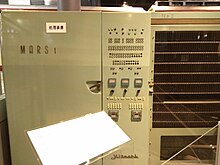This article has multiple issues. Please help improve it or discuss these issues on the talk page. (Learn how and when to remove these messages)
|

MARS (マルス, Marusu), short for Magnetic-electronic Automatic Reservation System, is a train ticket reservation system used by the Japan Railways Group (JR Group) companies and travel agencies in Japan. It was developed jointly by Hitachi and the former Japanese National Railways (JNR), and inherited by the Railway Information Systems Company [ja] (JR Systems), which is jointly owned by the seven railway companies of the JR Group: the East Japan Railway Company (JR East), Central Japan Railway Company (JR Central), West Japan Railway Company (JR West), Hokkaido Railway Company (JR Hokkaido), Shikoku Railway Company (JR Shikoku), Kyushu Railway Company (JR Kyushu), and Japan Freight Railway Company (JR Freight).
The MARS system used in JR ticket offices is Japan’s largest online real-time system, providing a year-round availability of 99.999%. It offers a range of services, including seat reservations on Shinkansen and Limited Express trains and fare calculation for basic fare tickets, commuter passes, and express tickets. It is currently connected to approximately 10,000 terminals at JR ticket offices and travel agencies, as well as to online systems run by the individual JR companies. The system is accessed about 8 million times every day, with a daily average of over 1.9 million tickets sold.
Outline

The host computer of the system was previously located in Kokubunji, Tokyo until 2013, when it was moved to an undisclosed location in the northern part of the Kantō region. The system is managed by JR Systems since 1 April 1987 following the division and privatization of JNR.
Ticket offices at JR stations equipped with MARS terminals are called Midori-no-madoguchi (みどりの窓口, literally "green window"), selling tickets of all JR Group trains and partly highway buses and route buses and ferries. It is possible for passengers to reserve tickets of buses and trains from one month prior to the given trip. In the JR Central region, these are instead called by the name きっぷうりば kippu uriba, meaning "ticket sales counter".
Naming
Originally short for "Magnetic-electronic Automatic (seat) Reservation System", the backronym was later changed to "Multi Access Reservation System". It has since been reverted to its original meaning.
History
MARS-1

The MARS-1 system was created by Mamoru Hosaka, Yutaka Ohno, and others at the Japanese National Railways' R&D Institute (now the Railway Technical Research Institute), and was built in 1958. It was the world's first seat reservation system for trains, and entered service in February 1960, initially only providing bookings for the Kodama and Tsubame limited express services. The MARS-1 was capable of reserving seat positions, and was controlled by a Hitachi mainframe transistor computer with a central processing unit consisting of a thousand transistors and a magnetic drum memory unit for data storage, which was where the MARS acronym originated from.
In 2008, the MARS-1 system received a "One Step on Electro Technology -Look Back to the Future-" commemorative plaque from the Institute of Electrical Engineers of Japan.

MARS 100/200
| This section is empty. You can help by adding to it. (June 2024) |
MARS 300
| This section is empty. You can help by adding to it. (August 2023) |
MARS 500
MARS 501
Introduced in stages between 2002 and 2004, the MARS 501 introduced the concept of an Ethernet-based client–server model. Also, the ticket paper type was changed to thermal paper.
MARS 505
The latest version of MARS uses the MARS 505 system which was introduced in April 2020, which expanded on contactless, and ticketless boarding and booking capabilities brought along by the rise of mobile apps on smartphones and tablets.
References
- "Corporate Overview - JR RAILWAY INFORMATION SYSTEMS CO., LTD". JR Systems. Retrieved 2023-12-05.
- ^ "About JRS - JR RAILWAY INFORMATION SYSTEMS CO., LTD". JR Systems. Retrieved 2024-01-13.
- ^ "Products and Solutions - JR RAILWAY INFORMATION SYSTEMS CO., LTD". JR Systems. Retrieved 2024-01-13.
- "データセンターサービス|鉄道情報システム株式会社". Archived from the original on 2023-06-28. Retrieved 2023-08-17.
- "List of the stations are installed for Midori no Madoguchi in JR East". Archived from the original on 2021-05-08. Retrieved 2021-06-02.
- "List of the stations are installed for Midori no Madoguchi in JR Hokkaido". Archived from the original on 2021-06-02. Retrieved 2021-06-02.
- Kawasaki, Hiroshi (2011). "Advancement and Issues of Transport Management and Signal/Train Control Systems" (PDF). JR East. JR EAST Technical Review-No. 20. pp. 7–11. Archived (PDF) from the original on 2023-12-10. Retrieved 2024-06-03.
- Ogawa, Tetsuya; Osumi, Hideki; Nagai, Satoru; Ito, Masakazu; Kato, Hiromitsu; Fushiki, Takumi (2011). "Convergence of Information Technology and Control Systems in Railway Transportation Service Systems" (PDF). Hitachi. Hitachi Review Vol. 60. Archived (PDF) from the original on 2024-04-20. Retrieved 2024-06-03.
- "Products and Solutions". JR Systems. Archived from the original on 2023-12-05. Retrieved 2024-06-03.
- "MARS-1-Computer Museum". IPSJ Computer Museum. Archived from the original on 2023-11-28. Retrieved 2024-06-03.
- "Hitachi Origin Story". Hitachi. Archived from the original on 2021-10-21. Retrieved 2024-06-03.
- ^ "Hitachi and Japanese National Railways MARS-1". IPSJ Computer Museum. Information Processing Society of Japan. Archived from the original on 2016-10-27. Retrieved 2017-04-19.
- "Early Computers: Brief History". IPSJ Computer Museum. Information Processing Society of Japan. Archived from the original on 2017-05-02. Retrieved 2017-04-19.
- "展示状況「座席予約システム:マルス1/みどりの窓口の先がけ」". 26 March 2019. Archived from the original on 2023-08-17. Retrieved 2023-08-17.
- "交通新聞 電子版|Jrシステム 新たなステージに対応 各種基盤整備の「マルス505」". Archived from the original on 2021-02-12.
External links
This Japanese rail transport related article is a stub. You can help Misplaced Pages by expanding it. |